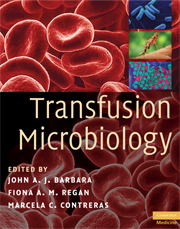Book contents
- Frontmatter
- Contents
- List of contributors
- Foreword
- Preface
- Acknowledgements
- Glossary
- Introduction: Transfusion-transmitted infections, then and now
- Section 1 Agents
- Section 2 Selection and testing
- 10 Blood donor selection and qualification
- 11 Current serological methods of testing and automation
- 12 Confirmatory testing and donor re-admission
- 13 The strategy for applications of nucleic acid testing
- 14 Nucleic acid testing: general view
- 15 Nucleic acid testing: the US approach
- 16 Nucleic acid testing: the UK approach
- 17 Quality in the screening of donations for transfusion-transmissible infections
- 18 Microbiological blood testing and new technologies
- 19 Processing and components: leucodepletion and pathogen reduction
- 20 Fractionated products
- Section 3 Surveillance, risk and regulation
- Index
- Plate section
- References
20 - Fractionated products
from Section 2 - Selection and testing
Published online by Cambridge University Press: 12 January 2010
- Frontmatter
- Contents
- List of contributors
- Foreword
- Preface
- Acknowledgements
- Glossary
- Introduction: Transfusion-transmitted infections, then and now
- Section 1 Agents
- Section 2 Selection and testing
- 10 Blood donor selection and qualification
- 11 Current serological methods of testing and automation
- 12 Confirmatory testing and donor re-admission
- 13 The strategy for applications of nucleic acid testing
- 14 Nucleic acid testing: general view
- 15 Nucleic acid testing: the US approach
- 16 Nucleic acid testing: the UK approach
- 17 Quality in the screening of donations for transfusion-transmissible infections
- 18 Microbiological blood testing and new technologies
- 19 Processing and components: leucodepletion and pathogen reduction
- 20 Fractionated products
- Section 3 Surveillance, risk and regulation
- Index
- Plate section
- References
Summary
Fractionated products are plasma proteins that have been extracted from pooled human plasma and manufactured into stable pharmaceuticals in dose forms suitable for clinical administration (Foster, 2005). The major categories of fractionated products are immunoglobulins for the treatment of disorders of immunity, the prevention of specific infections and the prevention of RhD immunization, albumin for volume and protein replacement and coagulation factors for haemostasis. The annual requirement for fractioned plasma products in the UK includes over 2000 kg of intravenous immunoglobulin (IGIV) for the treatment of more than 1800 patients with primary immune deficiency; 120,000 doses of anti-D immunoglobulin to prevent haemolytic disease of the newborn in about 65,000 pregnancies; over 5000 kg of albumin for tens of thousands of patients treated for burns, shock and major trauma. In addition, over 500,000 doses of factor VIII concentrate, recombinant or plasma-derived, are required to treat about 6000 people with haemophilia A. In the USA it is estimated that as many as 1 million patients are treated each year with products derived from human plasma, with over 400,000 recipients of albumin and more than 20,000 recipients of IGIV. Worldwide, some 25 million litres of human plasma are fractionated each year, providing over 500 metric tonnes of human protein for therapeutic use (see Table 20.1).
Blood-borne infections which exist naturally in the human population present a particular threat to recipients of fractionated products because each batch of product may be prepared from many thousands of donations and because some patients may be treated repeatedly throughout their lives, thereby considerably increasing their probability of exposure to a batch associated with an infected donation (Lynch et al., 1996).
- Type
- Chapter
- Information
- Transfusion Microbiology , pp. 259 - 304Publisher: Cambridge University PressPrint publication year: 2008
References
- 2
- Cited by

